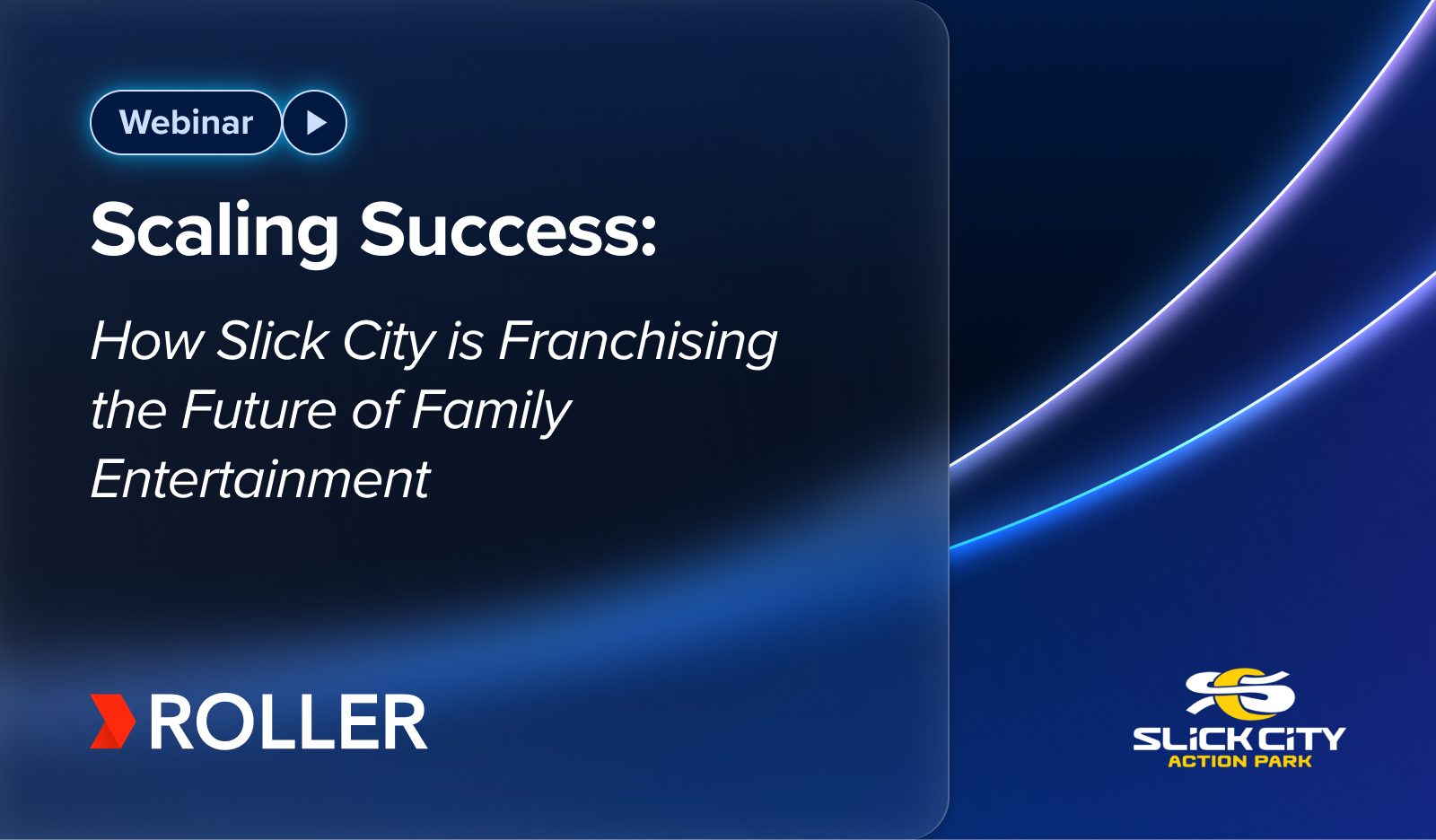Thinking about opening a trampoline park? You're not alone. With the industry booming and consumer demand for active entertainment on the rise, now is a great time to jump into this business. Whether you're drawn to the idea of creating a high-energy venue for families, fitness enthusiasts, or corporate events, a well-planned trampoline park can be a fun and profitable venture.
But launching a successful park involves more than just installing trampolines and opening the doors. From securing funding and picking a location to investing in top-quality equipment, choosing the right trampoline park software, and hiring the right team, there are many moving parts to consider. This guide will walk you through everything you need to know to help you build a thriving trampoline park that keeps guests coming back for more.
Why open a trampoline park?
Trampoline parks are one of the fastest-growing types of businesses in the entertainment industry, and for good reason. They offer a unique blend of fun, fitness, and social engagement, making them a popular destination for people of all ages.
A booming industry with strong revenue potential
With the global trampoline park market expected to reach $5.15 billion by 2033, now is a great time to consider launching a park of your own. North America leads the global market, accounting for 42.5% of total industry revenue. However, Europe and the Asia-Pacific region (including China, India, and Japan) are growing quickly due to increased investment in leisure and entertainment venues.
This growth is fueled by:
- Increasing consumer demand for active entertainment: more people are prioritizing experiences that combine fun with physical activity.
- The rise of trampoline-based fitness programs: drawing in both fitness enthusiasts and casual jumpers looking for a new way to stay active.
- Year-round accessibility: unlike outdoor amusement venues, trampoline parks can thrive in any season, ensuring steady foot traffic.
Revenue and profitability insights
From a financial perspective, trampoline parks can be highly lucrative. A well-managed venue can generate $1 million to $3 million in annual revenue, with industry-standard profit margins ranging between 15% and 25%. Several factors influence profitability, including:
- Location: High-traffic urban areas often yield higher revenues but come with greater lease expenses. Suburban locations may offer lower rent but require additional marketing efforts.
- Diverse revenue streams: Successful parks don’t rely solely on ticket sales; they increase profits through memberships, birthday party bookings, food and beverage sales, and corporate events.
- Operational efficiency: Investing in venue management software, self-service check-ins, and digital waivers can help reduce staffing costs and streamline daily operations.
A wide range of customers
Unlike some entertainment venues that cater to a specific audience, trampoline parks attract a broad range of guests, ensuring steady attendance year-round.
- Families with young children: Parents love trampoline parks as a safe and active way for kids to burn off energy.
- Teenagers and young adults: A go-to spot for social outings, group activities, and birthday parties.
- School groups and community organizations: Field trips, after-school programs, and youth events make up a large percentage of bookings.
- Corporate teams: Many businesses use trampoline parks for team-building events and company outings.
- Fitness enthusiasts – Trampoline-based fitness classes are gaining popularity, attracting adults who want an engaging, high-energy workout.
By catering to different demographics, trampoline parks create steady revenue streams and reduce seasonal slowdowns. Offering memberships, fitness classes, and exclusive party packages can further boost guest retention and long-term profitability.
How much does it cost to open a trampoline park?
Opening a trampoline park requires a significant financial investment, with total startup costs typically ranging between $500,000 to $3 million. The final price tag depends on several factors, including facility size, location, equipment, and technology.
The biggest expense for most trampoline parks is securing the right location. A typical trampoline park requires 25,000 to 40,000 square feet of space, often in warehouses or retail centers. Costs include:
- Leasing or purchasing the property
- Renovations and build-out expenses, such as installing flooring, lighting, HVAC systems, and fire safety measures
- Zoning permits and licenses, which vary by region
In high-traffic urban areas, lease costs are higher, but foot traffic can drive stronger revenue. Suburban and rural locations may have lower rent but require more marketing to attract guests.
Other costs include:
- Trampoline park equipment
- Technology and software
- Insurance and legal fees
- Staff salaries, recruitment, and training costs
Franchises vs. independent trampoline parks
One of the first big decisions when opening a trampoline park is whether to start your own independent venue or invest in a franchise. Both options come with advantages, and the right choice depends on your goals, experience, and available capital.
Franchise
Franchising offers a turnkey business model with built-in support, but it comes with higher upfront costs. Franchise fees typically range from $50,000 to $150,000+, covering access to an established brand, marketing support, and operational guidance. You'll also benefit from supplier partnerships and training programs, making it easier to get started. The brand recognition of a franchise can also help attract customers and drive faster revenue growth.
Independent
An independent trampoline park, on the other hand, generally has lower startup costs but requires building everything from the ground up. Owners have full creative control over branding, pricing, and operations, allowing for greater flexibility in revenue streams and promotional strategies. However, this also means developing business processes, staff training, and vendor relationships without external support.
If you want structure, support, and brand recognition, a franchise may be the way to go. If you prefer full creative control and the thrill of growing your own brand, an independent park might be the better fit.
Funding options for your trampoline park
Most new trampoline park owners secure outside funding to cover startup costs. Here are some of the most common financing options:
Small business loans
- Many countries offer government-backed loans with favorable interest rates. Check official government websites to explore available programs in your area.
- Traditional bank loans typically require a strong credit history and a well-developed business plan to qualify.
Private investors and partnerships
- Angel investors: These are individuals who invest their own money in high-growth industries like entertainment and attractions. Angel investors typically provide funding in exchange for equity or a share of future profits.
- Venture capital firms: These are investment firms that specialize in funding startups and high-growth businesses. Unlike angel investors, venture capital firms manage pooled funds from multiple investors and typically invest in businesses with strong scalability potential. They often provide not just capital but also strategic guidance and industry connections.
- Business partners: Partnering with a co-founder or strategic investor can help share the financial burden of launching your park. Business partners often contribute both capital and operational expertise, making them valuable assets for new entrepreneurs.
Franchise financing
Some trampoline park franchises offer financing assistance or preferred lender partnerships, making it easier to get started with an established brand.
Crowdfunding and community support
- Kickstarter, GoFundMe, and local investment groups allow for public contributions.
- Pre-selling memberships or event packages can generate early revenue before your park opens.
Each funding option comes with its own advantages and considerations, so it’s important to evaluate which aligns best with your growth goals and business strategy. Regardless of the route you take, having a well-researched business plan will significantly improve your chances of securing the necessary capital.
Trampoline park business plans
A solid business plan is essential for securing funding, defining your operational strategy, and ensuring long-term success. Whether you choose to operate independently or join a trampoline park franchise, understanding the financial and structural requirements will help set your business up for profitability.
Key sections of a trampoline park business plan
A well-structured business plan is essential for securing funding and creating a roadmap for success. Here’s what to include:
- Executive summary: A high-level overview of your trampoline park, highlighting its location, attractions, pricing model, and financial goals. Investors will often read this first, so make it clear and compelling.
- Market research and industry analysis: Understanding who your customers are—families, schools, corporate groups, fitness enthusiasts—and what the competition looks like helps you position your park effectively. Identify gaps in the market at your chosen location and find opportunities to stand out.
- Revenue model and pricing strategy: Outline all potential income streams, including ticket sales, party bookings, memberships, food and beverage sales, and merchandise. Detail your pricing strategy for general admission, group events, and loyalty programs.
- Operational plan: Cover the facility layout, equipment needs, staffing needs, safety protocols, and guest experience enhancements like digital waivers and self-service ticketing.
- Financial projections and funding needs: Break down startup costs (real estate, equipment, software, staffing, etc.) and provide revenue forecasts. A break-even analysis will show how long it will take to become profitable. If you’re seeking funding, outline how much capital is needed and where it will go.
Having a comprehensive business plan not only helps you secure funding but also serves as a strategic guide for successfully launching and scaling your trampoline park. By carefully planning each aspect, you’ll be better equipped to make informed decisions and ensure long-term profitability.
Trampoline park equipment
Investing in high-quality, safety-certified equipment is essential for both guest experience and risk management. Equipment costs vary based on park size and attractions but typically include:
- Trampoline courts, including wall-to-wall trampolines and freestyle areas
- Foam pits
- Airbags
- Ninja courses and climbing walls
- Basketball and dodgeball zones for interactive play
- Toddler-friendly soft play areas
- Arcade games
- Snack bars and concession stands
- Party rooms
Depending on the complexity and number of attractions, trampoline park equipment can cost between $100,000 to $750,000.
Read more: Top Concession Stand Foods: Bestselling Food and Drinks for Maximum Profit
Insurance and legal considerations
Even with the best equipment and strict safety measures in place, accidents can still occur. That’s why securing comprehensive insurance coverage and ensuring legal compliance is crucial for trampoline park operators. A well-structured risk management plan can help protect your business from liability claims and unforeseen financial burdens.
Key legal and insurance considerations include:
- General liability insurance: Standard business insurance may not fully cover trampoline-related injuries, so it’s important to obtain specialized liability coverage tailored to recreational facilities. Working with an insurer experienced in amusement parks can help ensure you have adequate protection.
- Business licensing and compliance: Trampoline parks must adhere to local regulations and safety codes, including fire codes, emergency procedures, and routine inspections. Ensuring compliance helps minimize risks and avoids costly legal issues.
- Waivers and legal agreements: Every guest should sign a clearly worded liability waiver acknowledging the inherent risks of trampoline activities. These waivers can provide an added layer of legal protection in the event of an injury claim.
Because trampoline parks involve high-energy physical activity, securing the right insurance and legal safeguards is essential. Investing in strong risk management practices can protect both your guests and your business from unnecessary financial and legal challenges.
Read more: Trampoline Park Safety Tips: How to Keep Guests Safe and Reduce Risks
The importance of liability waivers
Having every guest sign a liability waiver before participating is one of the most effective ways to reduce legal risks and ensure compliance with safety protocols. Digital waivers streamline this process, allowing parks to efficiently collect, store, and access signed agreements while reducing administrative burdens.
Why digital liability waivers matter
- Legal protection: In the event of an accident, a signed waiver provides proof that guests acknowledged and accepted the risks, helping safeguard your business against liability claims.
- Faster check-ins: Allowing visitors to complete waivers ahead of time speeds up entry, reduces congestion at the front desk, and enhances the overall guest experience.
- Instant access and organization: Unlike paper waivers that can be misplaced or damaged, digital versions are securely stored in the cloud, ensuring they remain easily accessible and organized.
Read more: Trampoline Park Liability Waivers: How a Digital Solution Can Make All the Difference
Staffing and training
Your team is the heart of your trampoline park, directly impacting safety, guest satisfaction, and overall business success. Hiring the right employees and providing effective training ensures smooth operations and a positive experience for visitors.
Hiring the right team
When hiring staff, look for enthusiastic, customer-oriented individuals who can create a fun and welcoming environment. Prior experience in the attractions industry isn’t always necessary—what matters most is a positive attitude and a willingness to learn. Here are some key steps to building a great team:
- Write compelling job descriptions: Treat your job postings like marketing materials. Highlight what makes your trampoline park a great place to work, including perks like flexible scheduling, career growth opportunities, or a team-oriented work culture.
- Prioritize customer service skills: Candidates should have strong interpersonal skills and the ability to interact positively with guests of all ages.
- Consider diversity and inclusion: A diverse team brings different perspectives and enhances the overall guest experience.
- Use a trial task: For customer-facing roles, consider having shortlisted candidates complete a simple task, such as greeting a mock guest or handling a basic customer query. This helps assess their suitability for the job.
- Start with a versatile team: In the early stages, hiring a small, flexible team allows you to manage costs while ensuring all essential roles are covered.
Training for success
Once hired, your staff must undergo thorough training to ensure they understand safety protocols, customer service expectations, and emergency procedures. Your training program should cover:
- Safety protocols: Since trampoline parks involve active play, staff must be well-versed in injury prevention, equipment monitoring, and enforcing park rules.
- Customer service excellence: Employees should be trained in greeting guests, assisting with questions, and handling conflicts professionally.
- Emergency response: Ensure that staff members know how to respond to injuries, fires, or other emergencies. First-aid certification for key team members is a plus.
- Hands-on practice: Give new hires real-world experience by allowing them to shadow experienced employees before taking on their full responsibilities.
Ongoing staff development
Hiring and training don’t stop after onboarding. Regular team check-ins, refresher training sessions, and employee recognition programs can improve retention and performance.
- Hold shift meetings: Brief meetings at the start of a shift keep staff updated on any changes, special events, or safety reminders.
- Encourage team feedback: Employees who feel heard are more engaged. Allow staff to provide input on operations and customer interactions.
- Recognize great performance: A simple thank-you, employee-of-the-month program, or small incentives can boost morale and keep your team motivated.
As your team grows, efficient scheduling becomes even more important. If you’re looking to streamline shift planning and optimize labor budgets, check out our integration with Workforce.com to see how syncing sales data with staff scheduling tools can improve efficiency and reduce staffing headaches.
A well-trained, happy staff leads to a safer, more enjoyable trampoline park experience for guests—and, ultimately, a more successful business.
Technology and software
The right technology can streamline operations, enhance guest experience, and boost revenue at your trampoline park. From online bookings to self-service kiosks, digital solutions make every visit smoother and more enjoyable.
Key tech investments to consider:
- Online booking and ticketing: A mobile-friendly checkout lets guests purchase tickets, memberships, and party packages in advance, reducing front-desk congestion and increasing sales.
- Digital waivers: Guests can sign waivers before arrival, cutting wait times and eliminating lost paperwork.
- Self-service kiosks: Faster check-ins and food orders free up staff while increasing upsell opportunities.
- Mobile food and beverage ordering: Guests order from their phones, reducing lines and increasing per-guest spending.
- Automated guest feedback: Post-visit surveys provide real-time insights to improve service and retention.
Using all-in-one trampoline park software like ROLLER helps manage these tools in one place, reducing admin work and optimizing operations.
Read more: 6 Ways to Improve the Trampoline Park Guest Experience with Technology
What’s next?
Opening a trampoline park is an exciting business venture—but success depends on smart planning and the right tools. ROLLER's all-in-one trampoline park software can help you handle bookings, payments, waivers, and more—so you can focus on running an amazing venue.
Book a demo today to see how ROLLER can help you set your park up for success.
Disclaimer: This article is not intended as legal advice. Venues should coordinate with the appropriate bodies for specific information about regulations and guidelines.
Frequently asked questions
Is owning a trampoline park profitable?
What are the biggest challenges of running a trampoline park?
Do I need a franchise to start a trampoline park?
What insurance is required for a trampoline park?
How can I streamline bookings and payments at my trampoline park?



